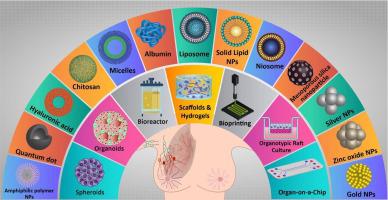当前位置:
X-MOL 学术
›
Coord. Chem. Rev.
›
论文详情
Our official English website, www.x-mol.net, welcomes your feedback! (Note: you will need to create a separate account there.)
Nanobiotechnological approaches for breast cancer Management: Drug delivery systems and 3D In-Vitro models
Coordination Chemistry Reviews ( IF 20.6 ) Pub Date : 2024-03-12 , DOI: 10.1016/j.ccr.2024.215754 Hossein Abolhassani , Alireza Eskandari , Anita Saremi Poor , Ali Zarrabi , Behnoosh Khodadadi , Sara Karimifard , Hamidreza Sahrayi , Mahsa Bourbour , Mohammad Tavakkoli Yaraki
Coordination Chemistry Reviews ( IF 20.6 ) Pub Date : 2024-03-12 , DOI: 10.1016/j.ccr.2024.215754 Hossein Abolhassani , Alireza Eskandari , Anita Saremi Poor , Ali Zarrabi , Behnoosh Khodadadi , Sara Karimifard , Hamidreza Sahrayi , Mahsa Bourbour , Mohammad Tavakkoli Yaraki

|
The science of nanotechnology has been proposed as a factor of main change in the field of cancer diagnosis and treatment. The challenges in common clinical treatment of breast cancer can be dominate by proof targeting of cancer cells by nanoscale drug delivery system. Due to specific properties of nanoparticles such as biocompatibility, minimum toxicity, excellent stability, multifunctional encapsulations of therapeutic agents, increased in permeability and retention effect, selective and proof targeting, they can apply for cancer therapy. Multidrug resistance to many of chemotherapy drugs is one of the main challenges in conventional chemotherapy that can be overcome by nanoparticles. However, and studies is limited in this field, and the number of approved nano formulation drugs has not increased significantly over the years.Successful clinical translation of nanomedicines is arduous requiring considerable preclinical tests. Two-dimensional (2D) monolayer cell cultures and animal models, which are routinely used for cancer research and drug discovery/screening seem inadequate. To address this challenge, biomimetic three-dimensional (3D) tumor models like spheroids, organoids, scaffolds/hydrogels, bioprinted, and microfluidic chips have been established using the breast tumor engineering approach. Taking the physiopathology of the breast cancer microenvironment into account, such models have the potential to enhance disease modeling and preclinical drug/nanomedicine screening. The development of 3D cancer models comprised of the patient’s own cancer, stromal, and immune cells can be exploited as a promising preclinical platform and provide personalized cancer therapy.
中文翻译:

乳腺癌管理的纳米生物技术方法:药物输送系统和 3D 体外模型
纳米技术科学已被认为是癌症诊断和治疗领域主要变革的因素。乳腺癌常见临床治疗的挑战主要是通过纳米级药物输送系统证明癌细胞靶向。由于纳米粒子的生物相容性、最小毒性、优异的稳定性、治疗剂的多功能封装、增加的渗透性和保留效果、选择性和证明靶向等特定性质,它们可以应用于癌症治疗。对许多化疗药物的多药耐药性是传统化疗中的主要挑战之一,而纳米粒子可以克服这一挑战。然而,该领域的研究有限,多年来批准的纳米制剂药物的数量并没有显着增加。纳米药物的成功临床转化是艰巨的,需要大量的临床前测试。通常用于癌症研究和药物发现/筛选的二维 (2D) 单层细胞培养物和动物模型似乎不够。为了应对这一挑战,利用乳腺肿瘤工程方法建立了仿生三维 (3D) 肿瘤模型,如球体、类器官、支架/水凝胶、生物打印和微流控芯片。考虑到乳腺癌微环境的病理生理学,此类模型有可能增强疾病建模和临床前药物/纳米药物筛选。由患者自身的癌症、基质细胞和免疫细胞组成的 3D 癌症模型的开发可以作为一个有前途的临床前平台并提供个性化的癌症治疗。
更新日期:2024-03-12
中文翻译:

乳腺癌管理的纳米生物技术方法:药物输送系统和 3D 体外模型
纳米技术科学已被认为是癌症诊断和治疗领域主要变革的因素。乳腺癌常见临床治疗的挑战主要是通过纳米级药物输送系统证明癌细胞靶向。由于纳米粒子的生物相容性、最小毒性、优异的稳定性、治疗剂的多功能封装、增加的渗透性和保留效果、选择性和证明靶向等特定性质,它们可以应用于癌症治疗。对许多化疗药物的多药耐药性是传统化疗中的主要挑战之一,而纳米粒子可以克服这一挑战。然而,该领域的研究有限,多年来批准的纳米制剂药物的数量并没有显着增加。纳米药物的成功临床转化是艰巨的,需要大量的临床前测试。通常用于癌症研究和药物发现/筛选的二维 (2D) 单层细胞培养物和动物模型似乎不够。为了应对这一挑战,利用乳腺肿瘤工程方法建立了仿生三维 (3D) 肿瘤模型,如球体、类器官、支架/水凝胶、生物打印和微流控芯片。考虑到乳腺癌微环境的病理生理学,此类模型有可能增强疾病建模和临床前药物/纳米药物筛选。由患者自身的癌症、基质细胞和免疫细胞组成的 3D 癌症模型的开发可以作为一个有前途的临床前平台并提供个性化的癌症治疗。



























 京公网安备 11010802027423号
京公网安备 11010802027423号